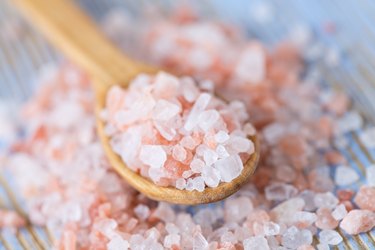
Himalayan pink salt and intermittent fasting have both been trendy over the last few years, and now the two are colliding. There's more and more chatter online about taking pink salt to help curb hunger during intermittent fasting. But does it actually work?
The answer depends on who you ask. While some fans of intermittent fasting say a mid-fast snack of plain salt keeps stomach rumbles at bay, most nutrition experts disagree. Here's a look at the debate and whether pink salt is worth trying during your fast.
Video of the Day
Video of the Day
What Is Pink Salt, Anyway?
Himalayan pink salt is a type of salt mined from the Salt Range mountains in the Himalayas. The salt gets its peachy pink tint from a concentration of beneficial minerals.
It's these minerals that make pink salt so popular in certain wellness circles. Compared to table salt, pink salt has higher levels of calcium, potassium, magnesium and iron as well as slightly less sodium, according to a February 2011 analysis in the Journal of Sensory Studies.
Can Pink Salt Help With Fasting?
Fasting for long periods can potentially cause the body to lose water and electrolytes, particularly sodium, says Lisa R. Young, PhD, RDN, adjunct professor of nutrition at New York University.
Proponents of intermittent fasting say that this water and electrolyte loss can trigger increased thirst, as well as symptoms like low energy, cravings and feeling hungrier than usual. The thinking goes that replacing these lost electrolytes with extra salt can curb those side effects and help a person on a fast feel less hunger.
"When the hunger pangs come, I take pink Himalayan salt and the hunger immediately goes away. I don't think I'd be able to fast as long without the salt," writes one Reddit user.
Some nutrition experts say this makes sense. "Supplementing with salt helps maintain adequate blood volume and maintain cellular hydration, which can help minimize hunger," explains Kayla Girgen, RD, LD, a dietitian based in St. Joseph, Minnesota, who practices intermittent fasting.
But why pink salt, specifically? It comes back to those extra minerals.
Similar to claims of maple syrup or coconut sugar being more nutritious than white sugar, some proponents see pink salt as "mineral-rich," and therefore, a healthier source of sodium compared to plain table salt. But in reality, the added benefits are very, very slight, Young notes. Girgen agrees: "The minerals are really just a bonus," she says.
Related Reading
Should I Take It?
Lots of enthusiastic intermittent fasters say that supplementing with pink salt helps curb their hunger so they can fast longer. But for now, there's no quality evidence to back this up.
While the body loses some amount of sodium on a short fast, the loss isn't thought to be enough to cause side effects — hunger or otherwise — for most people.
"Low sodium is not a concern for someone fasting 12 to 16 hours per day," says North Carolina-based dietitian Elizabeth Barnes, RDN. "If the body was so sensitive that it couldn't go 16 hours without extra sodium from pink salt, the human population would have died out long ago."
Young agrees: As long as you're drinking enough water throughout the day and replenishing your salt when you do eat, the sodium you lose while fasting isn't a major concern. And having an extra pinch of salt in between meals, "would only impact hunger very slightly," she says.
What's more, pink salt isn't any more likely to squash hunger than regular table salt. Even though it contains slightly higher levels of certain electrolyte minerals, they're not enough to make a noticeable difference, say Barnes and Young. According to Girgen, "table salt and pink salt would minimize hunger the same."
How to Take Pink Salt During Fasting
If you want to give pink salt or table salt a try while intermittent fasting, it's generally considered safe to do so, says Young. Just be sure to have it in moderation, because consuming too much sodium can raise the risk for high blood pressure.
"How much salt is needed depends on how long a person fasts as well as their eating style or diet," Girgen says. "A good rule of thumb is to aim for about 2,000 mg, or 1 teaspoon, of salt per day." (That means your total salt, including from food — not the amount of pink salt you should take.)
Not everyone agrees, though. "I would counsel my patients against taking pink salt as a supplement while intermittent fasting," Barnes says. She recommends instead that people make an effort to get their electrolytes from food, like potassium-rich potatoes, bananas, prunes, nuts and beans.
Another option for quelling mid-fast hunger? Hot water or bone broth. "Some people find warm fluids more satiating, but this is subjective and comes down to adequate hydration," Girgen says.
The Bottom Line
Supplementing with salt in general isn't likely to have a big effect on your hunger levels while intermittent fasting, and pink salt probably won't have more of an effect than regular table salt.
If you want to try it anyway, talk with your doctor about how much sodium is OK to add to your diet before consuming extra salt.
Related Reading